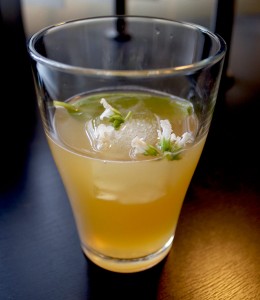Creative techniques put new spin on cocktails
There are only so many mornings that you wake up bloated with Keystone and endless shots of dirt-cheap Black Velvet before you realize there has to be something better.

Bye bye beer · This apple-gin-lemon drink garnished with basil flowers provides a welcome reprieve from typical college beverages. – Eddie Kim | Daily Trojan
Perhaps your experience can be summarized by this completely miscontextualized quote from Edgar Allen Poe: “I have absolutely no pleasure in the stimulants in which I sometimes so madly indulge.” Or perhaps you simply want to put down that warm frat-house Coke-and-rum and throw a nice cocktail party for once.
Playing mixologist, though, has less to do with buying a lot of expensive ingredients and more to do with how you use what you already have. Only three questions worth asking exist: What’s the base spirit? What’s the mixer? And do you serve it shaken or stirred?
For the sake of simplicity, let’s examine three spirits: vodka, gin and whiskey.
The best way to highlight neutral-tasting vodka is to be creative with technique. The caipivodka, a Brazilian favorite, makes for a perfect example. This strong, refreshing cocktail takes the national drink of Brazil, the caipirinha, and replaces cachaca — a rum-like spirit — with cheaper, college-friendly vodka.
Take a lime and cut it into eight wedges; toss the wedges into a shaker tin (see below) along with two teaspoons of regular sugar. Using a muddler or other thick, stick-like object (even the handle of a spatula or knife works in a pinch), crush the limes and sugar together to release the citrus juice. Add 1 1/2 ounces (read: large shot) of vodka, a handful of ice and shake vigorously. Serve over ice.
Gin might be more challenging to newer drinkers, but balancing the spirit with sweetness and acidity (as with the caipivodka) leads to some surprisingly pleasant results. Combine two parts gin, one part lemon juice and approximately three parts apple juice; shake with ice.
What you get is a not-too-sweet, not-too-sour drink laced with the intriguing flavor of juniper and herbs from the gin. Add a dash of Angostura bitters — an alcohol-based flavoring common in many cocktails and available at many supermarkets — and you have a libation worthy of The Varnish.
Now try the same concept with whiskey: Take two parts whiskey (Bourbon or rye whiskey work best), one part lime juice and three parts mango nectar. Shake with ice and garnish with a long slice of ginger: Summer perfection, with the woodsy punch of whiskey perfectly mellowed by the mixers.
As for shaking the drink: It’s an essential part of the cocktail, as the process creates an airy, light texture that works to enliven the drink — think of the texture of a frothy margarita. Both Boston shakers and Cobbler shakers work fine and go for as cheap as $10 on Amazon — look up the distinction online to see which you prefer. Honestly, even a medium-sized jar will work as a desperate measure, as long as you have a mesh strainer or other filter-type object to separate the shaken ice from the liquid. Though shaking times differ from person to person, as a general rule shake hard for around 10 seconds for any drinks served straight up and less for drinks on ice.
Though all the previous examples called for shaking, the “shaken or stirred” question applies most famously to a drink that everyone should try: the classic martini, composed of gin and dry vermouth, a special fortified wine with botanicals that add a special complement to the herbal bite of gin.
By the way: Though some turn away the vermouth, a martini isn’t quite a martini without it — a gin-to-dry vermouth ratio of 3:1 works well. As for those who prefer straight vodka shaken with ice … well, you’re just drinking cold vodka.
Silky, refreshing and elegant, the martini celebrates perfection via subtlety and simplicity, a philosophy that will lead any budding at-home bartender well. But perhaps more helpfully, the martini also presents a perfect lesson on when to stir, instead of shake, cocktails.
Forget Bond: Generally, expert bartenders — such as PDT’s brilliant Jim Meehan and Tailor Restaurant’s Eben Freeman — suggest stirring when a drink consists of only spirits, as with a martini. Part of the problem of shaking lies in the inelegant shards of floating ice it leaves behind. Even worse, shaking incorporates millions of air bubbles into the drink, ruining the silky, syrupy texture of a proper martini (or Manhattan, or Negroni, etc.) and making the drink cloudy.
The best tool for stirring? Weirdly, it’s a single chopstick. Use it to keep the ice spinning round the glass with minimal noise for 30 seconds or so, diluting and chilling the drink without incorporating air bubbles or cracking the ice.
As with cooking, crafting cocktails emphasizes basic ratios and techniques and improves with attention to detail and a willingness to experiment. But whether it’s watching Mad Men with martinis or lounging in the backyard on a balmy Sunday afternoon, a good (strong!) cocktail has the potential to take a nice moment and elevate it to a brilliant one.
